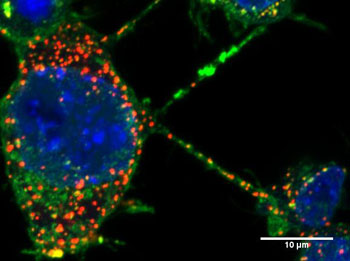Researchers Suggest Neurodegenerative Diseases May Spread through Nanotubes
By LabMedica International staff writers
Posted on 08 Sep 2016
A team of French neurological disease researchers has uncovered a mechanism that may explain how neurodegenerative diseases like Parkinson's disease spread inside the brain.Posted on 08 Sep 2016
Investigators at Institut Pasteur (Paris, France) described the movement of alpha-synuclein aggregates from damaged neurons to undamaged neurons through novel structures called tunneling nanotubes (TNTs) that connect cells within the brain.

Image: Neuronal cells connected by tunneling nanotubes containing synuclein fibrils (aggregates in red) (Photo courtesy of the Institut Pasteur).
Classically considered an unstructured soluble protein, wild-type alpha-synuclein forms a stably folded tetramer that resists aggregation. Nevertheless, alpha-synuclein aggregates to form insoluble fibrils in pathological conditions characterized by Lewy bodies, such as Parkinson's disease, dementia with Lewy bodies, and multiple system atrophy. These disorders are known as synucleinopathies.
The investigators reported in the August 22, 2016, online edition of The EMBO Journal that using quantitative fluorescence microscopy with co-cultured neurons, they had found that alpha-synuclein fibrils efficiently transferred from donor to acceptor cells through TNTs inside lysosomal vesicles. Following transfer through TNTs, alpha-synuclein fibrils were able to seed soluble alpha-synuclein aggregation in the cytosol of acceptor cells.
The investigators proposed that donor cells with lysosomes overloaded with alpha-synuclein aggregates disposed of this material by hijacking TNT-mediated intercellular trafficking. These findings revealed a possible novel role of TNTs and lysosomes in the progression of synucleinopathies.
Related Links:
Institut Pasteur















